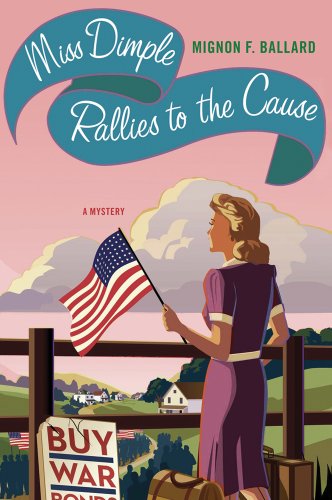
Mignon F. Ballard has long entertained readers with her cozy mysteries featuring Augusta Goodnight, a temporary guardian angel. Last year, in the highly acclaimed cozy, Miss Dimple Disappears, Ballard introduced us to another affable series character, Miss Dimple Kilpatrick, a no-nonsense first grade teacher in a small southern town during World War Two. In Miss Dimple Rallies to the Cause, we continue to see the effects of war on small-town America.
In early autumn 1943, just as planning has begun for the war bond rally, the town of Elderberry, Georgia has closed the schools for a few days while children, mothers and teachers are all picking cotton at a local farm, hoping to get it to the gin before the rains come. The young men have long gone to war, so it’s up to those left behind to be sure the things that need doing get done.
First grade teacher Miss Dimple Kilpatrick is instructing her students to pick cleanly.
“Just lift the fluffy cotton out of its cup,” she told one overly enthusiastic picker who was snatching entire bolls and cramming them into his bag. Her father, she remembered, had referred to that as “lazy man’s picking.”
“This way,” she continued, demonstrating to her class, “somebody won’t have to come behind you and separate the bolls before the cotton goes to the gin.”
Meanwhile, in spite of being repeatedly told to avoid the woods and the creek, fourth-grader Willie Elrod coaxes Junior Henderson to climb an overhanging tree branch and pitch sticks in the creek. They’re having a fine time until their teacher, Miss Annie Gardner, comes along demanding they climb down. The boys are running to join the other kids in the cotton fields when they hear Miss Annie scream.
Why was Miss Annie making such a big fuss about an old pile of rags? Willie turned to go back to where his teacher and several others gathered at the edge of the woods. Miss Moss, the sixth grade teacher, was crying and hollering so that one of the mothers had to lead her away, but then she was always carrying on about something. He hoped she’d retire before he got that far—if he ever did.
“It’s probably just an animal,” one of the teachers suggested.
“That’s no animal. Somebody call the sheriff!” another shouted.
The sheriff? Wow! This was getting interesting. Willie edged closer for a better look. And that was when a hand came down on his shoulder.
“William Elrod! You have no business down here. Now hurry on back with the others where you belong.”
Willie sighed. You didn’t argue with Miss Dimple Kilpatrick.
The body in the woods is only one of the mysteries the residents of Elderberry face while they are trying to adjust to a war that creates so many homeland sacrifices, not the least of which is the daily worry about the safety of the young men gone off to war.
And as soon as she saw Arden’s tear-stained face she knew something had happened to Hugh. Charlie had gone through all eleven years of school with Arden Brumlow, and although they had never been close friends, she’d always liked Hugh’s sister and even felt sorry for her for having to put up with her dictatorial mother. Today she didn’t wait to be asked in, but instead pushed open the door and took Arden in her arms while Miss Dimple stepped inside behind her.
“Is it Hugh?”Charlie asked, and Arden nodded. “Wounded—somewhere in the Solomons. We don’t know how he is, or even where he is.”
Miss Dimple Rallies to the Cause saturates the reader with the details of daily during a time when every man, woman, and child was locked in battle with a common enemy. There were so many changes to get used to: sugarless recipes, women working in munitions plants, walking great distances to save on gasoline, and, something I’d never heard of, the transformation of the way in which Americans saluted their flag.
After the color guard led everyone in the Pledge of Allegiance, Alma, accompanied by a trio from the reed section of the high school band, gave her rendition of “America the Beautiful.” Thanks to the three young musicians, the soloist stayed more or less on key, and the few times she strayed, they managed to drown her out. Dimple found she had been clenching her fists for the duration of the song, but had actually flinched only once. It had been less than a year, she recalled, when President Roosevelt had the salute to the flag changed from holding the right hand out toward the banner to placing it over one’s heart because the former resembled the heinous tribute to Adolph Hitler.
The people of Elderberry are among the most appealing characters who’ve ever occupied the written page. And the sweeping changes to small town life in America during a time of war—the way people pulled together—are lessons we can use today. I look forward to spending time with Miss Dimple in future novels.
According to Terrie, writing short mystery fiction is nearly as much fun as hanging out with any or all of her seven grandchildren. She is editor of the recently released anthology, Murder New York Style: Fresh Slices and blogs at Women of Mystery.

It is amazing how well Amazon tracks what we like, what we look at and what we buy. I just got an email from them and, among the seven cozy mysteries they suggested for me was, TA DA, Miss Dimple Rallies to the Cause. (Which I didn’t buy on Amazon.) I’m not sure that I like Amazon knowing my taste so well, but I am sure I like Miss Dimple, so I guess no harm done. Have to go now and check out the other cozies they suggest.